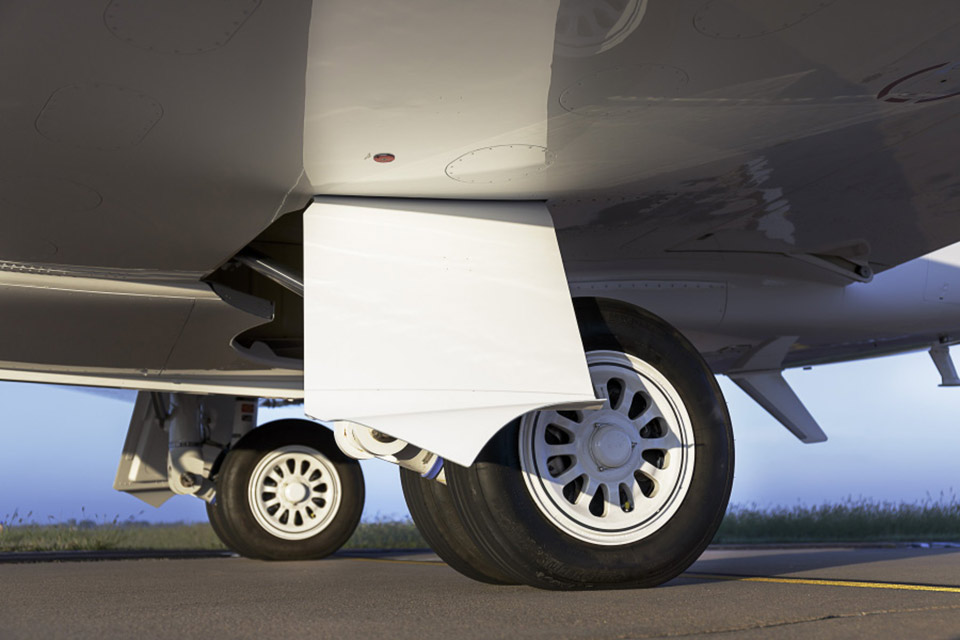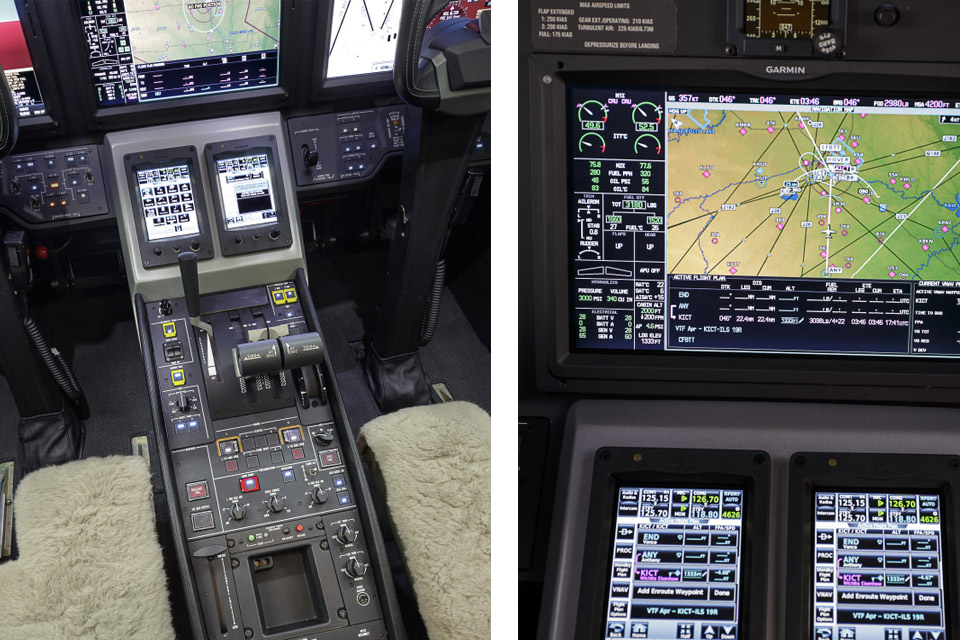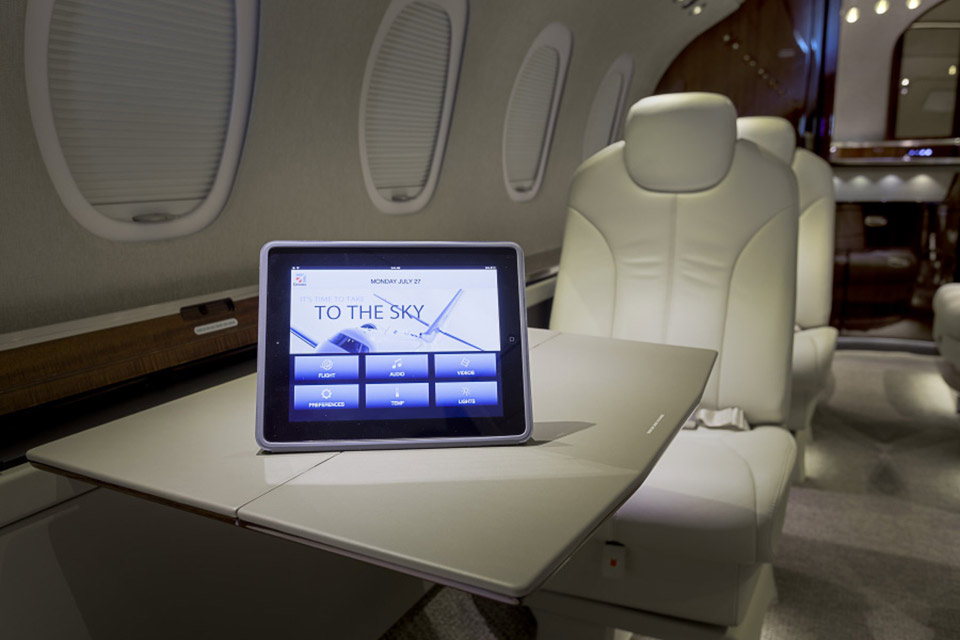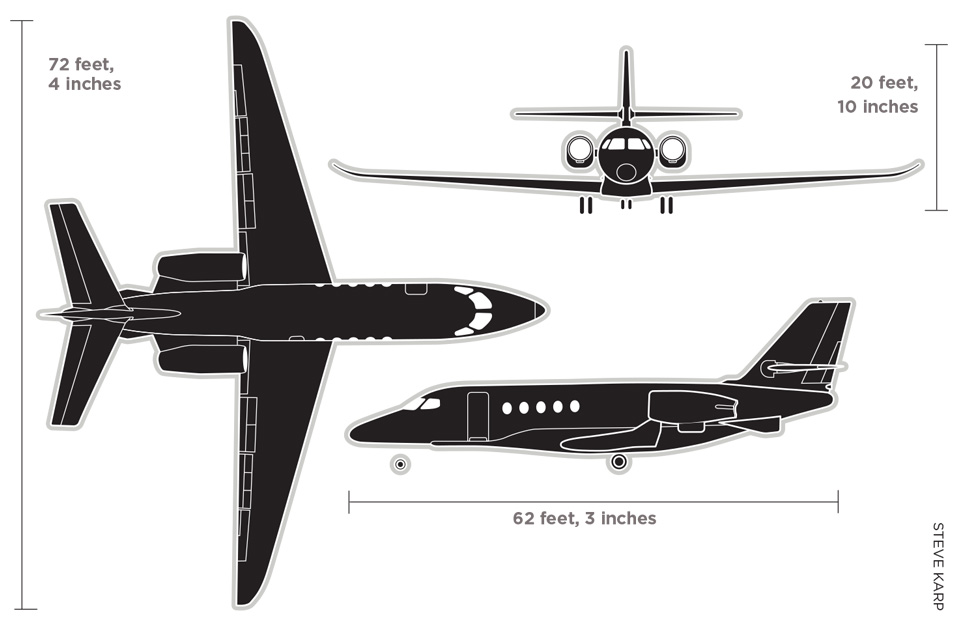The June 2015 certification of the new Cessna Citation Latitude put a punctuation mark on Textron’s acquisition of Beechcraft. It was the first airplane certified by the new ownership entity, and it bears some features that may well hint at the look of the future Citation product line.
First off, the Latitude is basically a Sovereign+ with some decidedly big-jet features. So it’s an evolutionary design, much like the rest of the Citation fleet. Following Cessna’s longstanding tradition of filling incremental niches between models, the Latitude—with its 2,700-nautical-mile range—fits in the slot between the 2,100-nm Citation XLS+ and the 3,190-nm Sovereign+. However, range is not the only relevant specification here. Instead, the Latitude’s emphasis is on the cabin.
In a big departure from traditional Citation design, the Latitude sits high on the ramp and has a proper airstair door, complete with handrail. The door extends by gravity and retracts electrically. There’s also a 77-inch-wide flat floor. So the airplane’s ramp presentation, interior aura, and comfort are more like those of a much larger airplane. The cabin windows are 25 percent larger than previous Citations; the cabin height is a full six feet; and there are fully articulating seats, a vacuum toilet with external servicing, an auxiliary power unit, and Textron’s Clarity wireless cabin management system.
The Clarity uses an app that runs on iPads and other portable devices to let passengers control cabin lighting, temperature, a media server, and Sirius XM radio. A forward bulkhead-mounted video monitor shows aircraft position, and the ship’s audio system has a subwoofer for maximum impact when watching those action movies. Worldwide Internet and telephone connectivity also is possible, either through AirCell or Inmarsat’s Swift 64 services—or both, as an option. The standard interior configuration has nine seats with a forward-club setup, a two-place side-facing divan, and closets both forward and aft. An eight-seat interior has a larger refreshment center up front and a single-place divan. Worth mentioning is the 32-inch space separating the club seats. This is the widest distance of any Citation, and helps prevent knocking knees when the cabin is full. Here’s another first: no shoulder belts on passenger seats. Static crash testing determined that passengers would not flail to the extent of major injury; part of the reason is the larger interior space.
To sum up, the Latitude won’t have you mincing your way up a fold-down entry ladder or shuffling down a dropped aisle. Instead, the cabin more closely resembles that of a Bombardier Global, Embraer, Falcon, or Gulfstream jet.
As for the cockpit, there are other big-jet features that distinguish the Latitude from the single-pilot Citations. Garmin’s G5000 avionics and its large three-screen displays, for one, plus autothrottles (also manufactured by Garmin) and four Garmin GTC 570 touchscreen control panels. Of course, the panel is NextGen-ready, with Automatic Dependent Surveillance-Broadcast Out/In (ADS-B Out/In), traffic alert and collision avoidance system (TCAS II), synthetic vision, Class A terrain awareness and warning system (TAWS), WAAS LPV, and RNP 0.3 capability, plus all the European Aviation Safety Agency-mandated controller-pilot datalink communications (CPDLC) equipment necessary for flying in Europe and over the North Atlantic. The panel has a well-organized, uncluttered look, thanks to Cessna’s moving many switches from the forward tilt panels to the large center pedestal.
In the cockpit
Ready to launch? Begin by entering your flight plan, weight and balance, and desired speed schedules on the central GTC 570s, and then set up the primary flight displays using the side-mounted touchscreens. At our relatively light takeoff weight of 23,684 pounds—about 6,000 pounds below the airplane’s max takeoff weight—the airspeeds were bugged for a flaps-2 takeoff: V1 was 104 knots, VR was 105, V2 was 117, and our engine-out initial climb was 180 knots. My demonstration pilot, Errol Wuertz, deftly entered all the data in seconds. Then it’s a matter of pushing first a start switch, waiting for 10 percent N1, and then pushing a FADEC switch and waiting for light-off. System synoptic pages let you monitor the electrical, fuel, hydraulic, and flight control systems during the preflight checks.
The panel displays can be set for split-screen views, so the multifunction display was set up to show our engine and systems information, flight-planned route, and Garmin’s SafeTaxi and Surface Watch views for runway and taxiway awareness. A slight shove on the thrust levers, and we were taxiing. The hydraulically actuated, self-centering tiller is sensitive, so it takes a bit of practice to make smooth corrections.
Then we were lined up for takeoff and cleared to go. Everyone uses the autothrottles, Wuertz said, so I decided to let them do the work. Besides, I don’t have much experience with them. For takeoff, arm the autothrottles (let’s just call them ATs from now on) by pressing the On/Off buttons at the sides of the thrust levers, and then advance them. At about half travel, the ATs take over and begin to set power automatically. That’s when the pilot lets go of the levers. I was still steering—the tiller isn’t needed for takeoff or landing—and hand-flying, but it’s like an invisible hand taking over the power management.
And what power there is. All those V-speeds swept by as I rotated our lightly loaded Latitude off the runway and into a 5,000-fpm climb. Just as we’d programmed, the ATs set power for a 250-knot climb up to 10,000 feet; after that, we’d climb at 270 knots. And even though it was a 99-degree Fahrenheit day at Wichita’s Dwight D. Eisenhower National Airport, it took us a mere 24 minutes, 10 seconds to reach FL450.
After leveling off, the ATs left the power at maximum continuous thrust for 10 minutes while we accelerated. Then the ATs backed off to give us maximum cruise power. The result was 435 KTAS/Mach 0.77, burning 1,370 pph/205 gph. Max cruise speeds of 450 KTAS can be obtained in the denser air at FL330, but at the cost of burning 150 more gallons per hour.
I ducked back to sample the cabin and imagine myself as a captain of industry. The seats, now designed and built in-house by Textron, were wide and comfortable; fully articulating; and berthable for those executive catnaps. There’s plenty of elbow room, and yes—it was a stand-up cabin for me (I’m 5 feet, 11 inches). I could easily talk with others in the cabin; there’s a general sense of roominess, so it’s easy to understand why fractional operator NetJets has 15 Latitudes on order.
Envelope protection
Back in the cockpit, it was time for a descent, which was more like a dive. This gave me a chance to check out the Latitude’s flight-envelope-protection features. Once the airplane reached redline, the ATs automatically reduced thrust and the autopilot gave nose-up commands. Similarly, underspeed and stall protection measures make the ATs power up the engines and the autopilot nose over to recover airspeed.
The Latitude also has emergency descent management. EDM is designed to take over should the crew become incapacitated by hypoxia, and it is active when flying above 30,000 feet. If cabin altitude rises to 15,000 feet or higher and the pilots take no corrective action, the system will automatically command an AT power reduction, a 90-degree turn (to clear an airway), and a descent to 15,000 feet, where a level-off occurs.
Even though the Latitude wing uses ailerons and three of its five hydraulically actuated spoiler panels for roll control, the airplane is heavy in roll. Pitch forces, less so—perhaps owing to the one-piece, trimmable horizontal stabilizer. Incidentally, as part of its Part 25 damage-tolerant design, the ailerons and stabilizer are driven by dual, independent systems that allow either pilot to control roll or pitch in the event of a control jam.
For the landings on Eisenhower National’s Runway 19L it was full flaps and gear down at the final approach fix, with ATs set to an approach speed of 120 knots. I kicked off the autopilot and got to sample the roll and pitch forces in rowdy thermals. Every time airspeed is gained, the ATs come back; every time airspeed nods off, they power up. The main thing is that they nail airspeed unerringly. On short final, Wuertz selected our VREF of 96 knots and the ATs retarded some more. At 50 feet agl, they automatically disconnect and power goes to idle. A disembodied female voice calmly says “Autothrottle”—meaning the ATs are off and it’s all yours, buddy.
You might think it’s impossible to bounce an airplane weighing 20,000 pounds. You’d be wrong. My first touchdown was, as they say, firm. It was a three-pointer with a rebound that sent the ship, oh, as high as a mailbox. With some corrective aft-stick pressure, the second recovery landing was much more pleasant, but things got busy because immediately after landing the drill is to yank back on the speedbrake handle, hit the thrust reverser triggers, and then pull back on them to initiate reverse thrust—all while jumping on the brakes. Bottom line: The dual, trailing link main gear and dual nosewheel saved the day.
My next landing was much more acceptable. This time I had a better idea of the sight picture, and I flared earlier and higher. Well, let’s just say I flared, period, compared to the first landing.
A subsequent flaps-2 takeoff included a V1 cut right at liftoff. Oh, boy. Wuertz pulled the right engine as we passed through 100 knots and I raised the nose. Spring-loaded for adventure, I found none. Instead, a bleed-air-driven rudder bias system fed just the right amount of pressure into the left rudder pedal. I only had to push it a little bit while I focused on nailing the V2 of 115 knots and accelerating to our final takeoff speed of 180 knots. While Wuertz retracted the gear and flaps, I noticed we were climbing at 3,100 fpm.
A definite choice
Make no mistake. The Latitude’s performance and design details are targeting a specific competitor new to the mid-size and super-midsize category: Embraer’s Legacy 450. It’s revealing that both airplanes have airstair doors; flat floors; envelope protection; autothrottles; interactive, big-screen avionics; single-point refueling; APUs; up to nine passenger seats; and, yes, even airline-style toilets. The Legacy 450 also has a biggish cabin and advertises a 2,500-nm long-range cruise capability with four passengers; the Latitude offers a range of 2,700 nm with a max payload of 1,000 pounds. Weights for the Legacy 450 had yet to be published as of this writing, so its payload/range trade-offs are still up in the air, so to speak.
What the Latitude and Legacy 450 don’t share is a common philosophy regarding flight controls. Like all Citations, the Latitude’s flight controls are actuated via cables, pushrods, bellcranks, and other purely mechanical and hydro-mechanical means. Embraer is committed to digital fly-by-wire controls for its mid-size jets; no cables here, just electrons connecting the cockpit to the control surfaces. Those faithful to Citations will find reassurance in the Latitude’s new features in a traditional package. Those intrigued by fly-by-wire’s workload-saving and safety advantages will have their curiosity piqued by the Legacy 450. Those in the market for a new mid-size jet will find a comparison worthwhile. AOPA
Email [email protected]
SPEC SHEET
Textron/Cessna Citation Latitude
Base price: $16.25 million
Specifications
Powerplants | (2) Pratt & Whitney PW306D1, 5,907 lbst ea
Recommended TBO | 6,000 hr
Recommended HSI | 3,000 hr
Length | 62 ft 3 in
Height | 20 ft 10 in
Wingspan | 72 ft 4 in
Wing area | 542.5 sq ft
Wing loading | 56.8 lb/sq ft
Power loading | 2.6 lb/lbst
Seats | 2 + 8/9
Basic operating weight | 18,656 lb
Max ramp weight | 31,050 lb
Max takeoff weight | 30,800 lb
Max zero fuel weight | 21,200 lb
Useful load (payload and fuel) | 12,394 lb
Max payload | 2,544 lb
Payload w/full fuel | 1,000 lb
Max landing weight | 27,575 lb
Fuel capacity | 11,394 lb (1,700 gals)
Baggage capacity, aft | 1,000 lb, 100 cu ft
Performance
Takeoff runway length (MTOW) | 3,580 ft
Rate of climb | 3,800 fpm
Rate of climb, one engine | 1,145 fpm
Landing distance (MLW) | 2,480 ft
Max cruise speed (mid-cruise weight/35,000 ft) | 446 KTAS
NBAA IFR range (200 nm alternate) | 2,850 nm
Max operating altitude | 45,000 ft
Service ceiling, one engine | 27,620 ft
Sea-level cabin to | 25,400 ft
Limiting and recommended airspeeds
VR (rotation), flaps 2 | 107 KIAS
V1 (takeoff decision speed) | 106 KIAS
VMCA (min control w/one engine inop, air), flaps 1 | 88 KIAS
VMCA flaps 2 | 83 KIAS
V2 (takeoff safety speed) | 115 KIAS
VFE (max flap extended), flaps 1 | 250 KIAS
flaps 2 | 200 KIAS
full flaps | 175 KIAS
VLE (max gear extended) | 210 KIAS
VLO (max gear operating) | 210 KIAS
VREF (reference speed, final approach) | 108 KIAS
VMO (max operating speed, 8,000 ft to 29,833 ft) | 305 KIAS
VMO (max operating speed, SL to 8,000 ft) | 270 KIAS
MMO (max Mach number, 29,833 ft and above) | 0.80 M
For more information visit the Textron Aviation website.
All specifications are based on manufacturer’s calculations. All performance figures are based on standard conditions and maximum weights unless otherwise noted.
Extra
At 45,000 feet and high-speed cruise power, the Latitude can fly as far as 2,000 nm in four hours, 58 minutes.
View the video:










